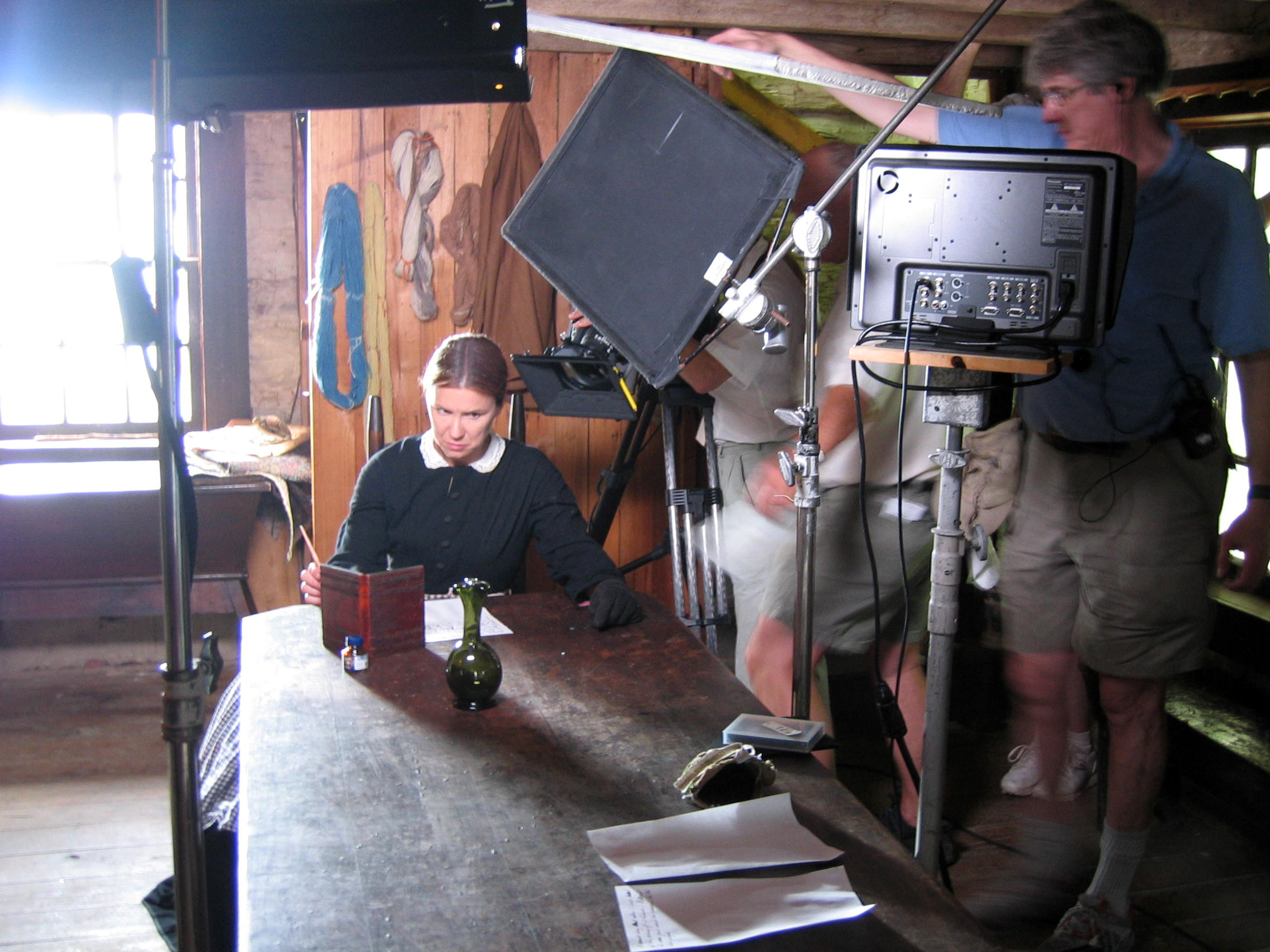
Pamela Mason Wagner on set filming Christmas and the Civil War (2006). Courtesy of Pamela Mason Wagner.
Pamela Mason Wagner is a producer, director, and writer specializing in historical docudramas: retelling stories from both the recent and ancient pasts, which necessitates a certain amount of artistic license to fill in missing details. She directed the Vancouver segment of Art in the Twenty-First Century, Season 8, and she has worked on a number of documentaries that have been broadcast during primetime on channels like PBS, CBS, ABC, NBC, Discovery, National Geographic, History, TLC, Hallmark, and MSNBC. Her IMDB profile reveals she even worked with the Irish actor Liam Neeson on a documentary about St. Patrick.
Directing and producing documentaries on such historical topics as the Civil War and Joan of Arc means acknowledging the limited availability of factual information about the subjects, and telling such stories visually requires the use of reenactments. Perhaps the clearest example of something inspired by a true story, a reenactment attempts to communicate the truth of past events through an interpretation that’s recognized and understood by viewers.
Lindsey Davis: How does the process of staging an event for a reenactment begin?
Pamela Mason Wagner: When I’ve utilized a reenactment as a tool to help tell the story, everything begins with the script. First you must know the story you want to tell; then you figure out what images and actions and moments will help you tell it. I often collaborate with screenwriters, who have a gift for sitting in a room and dreaming up incredible scenes based on their deep research into the subject. Then, typically, I’ll go location-scouting with those scenes in mind, in search of places in which to stage them. Often the locations suggest new ideas.
One example is my film Christmas and the Civil War, which tells the story of the five Christmases between 1861 and 1865, using words taken from diaries and slave narratives. We were searching for a place to shoot a scene of an enslaved person escaping. We found a bridge over a stream and shot the scene from the bridge, with the actor below, wading in the water. The concept grew from “running away” to “running away in water to avoid leaving a scent for the dogs in pursuit.” Finally, in postproduction, we added sound effects of the dogs barking, along with music, the spiritual “Wade in the Water,” sung by the actor. So that’s one example of how a location can really heighten the drama and elevate a point in the story.

A scene depicting Cornelia McDonald, a wealthy confederate woman from Winchester, VA writing in her diary. From Christmas and the Civil War (2006). Courtesy of Pamela Mason Wagner.
LD: When it comes to restaging an event, are there any filmmaker rules or tricks of the trade?
PMW: I believe once the stage is set—the actors are in place, wearing the right costumes, carrying the correct props—you draw on the talent in the room. As a director, I will describe the scene we are trying to reenact and then seek input from the actors about how best to achieve it. I loosely block the scene, with the help of an assistant director, and I always shoot the master first and encourage the actors to improvise. We keep what works and go in for close-ups on significant details. I suspect this process is quite different from how a feature-film director would approach the set. With documentaries, there is room for more than one voice in the conversation about how to achieve the end result.
LD: How does footage of a reenactment add to a documentary’s storytelling strength?
PMW: Most often I’ve used reenactment footage when there was no alternative. For example, sometimes the story took place prior to photography and motion pictures. But I directed a documentary about a man wrongfully incarcerated for twenty-two years for a crime he did not commit (circa 1979), and there was no imagery to help tell the story; the state of Tennessee had destroyed all of the records of his case. Without a reenactment, I could essentially only offer a radio play. Reenactment was critical to telling his very moving exoneration story.
LD: How do you feel about the use of reenactments in nonfiction film projects?
PMW: I know this is a hot-button issue in journalism circles, but since I come out of a drama/film-studies background, I have no problem with the use of reenactments in a nonfiction film. I think audiences these days are sophisticated enough to realize what they are looking at, and they understand the filmmaker is not trying to trick them.
A clip from Reluctant Saint: Francis of Assisi (2003). Courtesy of Pamela Mason Wagner.
PMW: One of my favorite films, about St. Francis of Assisi, was shot in Italy. Many of the reenactments were inspired by Giotto’s gorgeous frescoes. The day came to shoot the famous scene in which Francis takes off his luxurious garments, gives them back to his earthly father, and dedicates his life to his heavenly father. My executive producers urged me to not shy away from nudity, even though the project was destined to air on the family-friendly Hallmark Channel. We decided to stage the camera inside the church, to shoot through the open church door, seeing Francis in silhouette from behind, as he faced out toward the plaza. Rear male nudity seemed somehow more acceptable! The costume designer created a discreet codpiece to cover the actor in front, which couldn’t be seen by the camera from behind. Meanwhile a crowd had gathered in front of the church, mostly grandmothers in their seventies, who brought lawn chairs. Of course, we had to shoot multiple takes; each time the actor slowly took his clothes off and threw them at his earthly father, a large round of applause erupted from the grannies. Now, come on—you want to post that scene to your website, don’t you?



